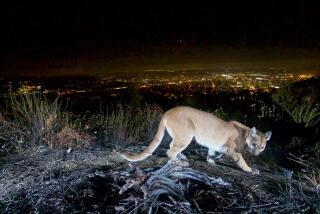Fifth mountain lion diagnosed with mange, possibly linked to rat poison
- Share via
P-53 didn’t look like her usual self when researchers observed her through remote camera images. Her fur was scruffy, making her face look swollen, and her eyes were squinted nearly shut.
She has mange, a parasitic skin disease that causes crusting and skin lesions, the researchers determined.
Jeff Sikich, a biologist studying the mountain lions, quickly recaptured P-53 and treated her, before releasing her back into the wild. Now, researchers are waiting to see how she will react to the treatment, said Kate Kuykendall, a spokeswoman for the National Park Service.
National Park Service researchers say there’s a link between mange and rat poison ingested by wild cats, but they don’t understand the nature of that link. It’s likely that mountain lions that ingest rat poison develop weaker immune systems, making them more susceptible to mange.
P-53 is the fifth mountain lion in the National Park Service’s study to be diagnosed with mange since 2002, when researchers began studying the animals in the Santa Monica mountains and their behavior in an urban habitat, according to a Thursday news release. The diagnosis has sparked renewed attention to the issue of rat poisons and how they’re affecting mountain lions in the area.
Mange is generally rare in wild cats, but since 2002 researchers have observed a decline in the bobcat population due to the disease, according to the news release. Studies have shown that bobcats that have ingested rat poison are more likely to have mange and die from it, Kuykendall said.
The relationship between rat poison and mange in mountain lions is less clear. Of 18 mountain lions that researchers have tested, 17 had rat poison compounds in their system, including four diagnosed with mange, Kuykendall said. P-53’s test results have yet to confirm the poison in her system.
“We’re not exactly sure yet,” Kuykendall said. “Our research hasn’t found a cause and effect, but we have found an association.”
Researchers also don’t know how mountain lions that have mange fare in the wild without treatment. Of the five diagnosed cats, two have died due to internal bleeding caused by rat poison ingestion. A third mountain lion also diagnosed with mange died a year after treatment, but researchers were unable to find its body in time to determine a cause of death.
The mountain lions with the poison in their system probably ingest it through their prey, such as coyotes, which feed on smaller rodents that have come by the poison in urban environments.
P-53’s lab results will reveal whether the cat was exposed to first- or second-generation anti-coagulant compounds. The second-generation compounds are believed to be stronger and more harmful, and have been banned from consumer purchase, Kuykendall said. However, National Park Service researchers say both poisons could be harmful to wild cats.
“Poison is poison,” Kuykendall said.
P-22 is the only mountain lion to have recovered from mange after being treated by the researchers. The popular “Griffith Park” mountain lion was caught and examined in April 2014 after cameras captured images of him looking a lot like P-53 does now. He was treated with topical medications and vitamin K injections and was released. Tests revealed P-22’s blood had compounds from two different rat poisons.
Last year, the Santa Monica Mountains National Recreation area and the Santa Monica Mountains Fund launched a campaign called #BreakThePoisonChain to educate people about the potential negative impacts rat poison has on wildlife.
Twitter: @r_valejandra
More to Read
Sign up for Essential California
The most important California stories and recommendations in your inbox every morning.
You may occasionally receive promotional content from the Los Angeles Times.











